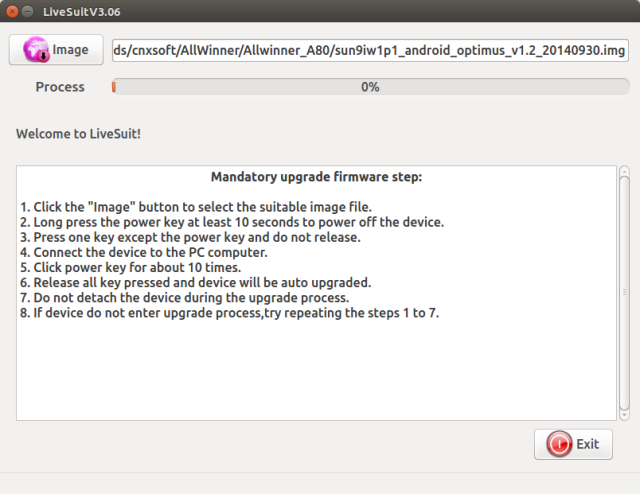After informing Allwinner I had some rather slow write speed (3MB/s) to the NTFS partition of my USB drive on my A80 OptimusBoard, they kindly provided a new compressed Android firmware image (sun9iw1p1_android_optimus_v1.2_20140930.img.7z) with some NTFS optimizations that can be downloaded from baidu (password: x2tz), mega.co.nz or simos.info (please only use this link, if the other two do not work as it’s a private website and monthly bandwidth may be limited).
I vaguely remember tools like LiveSuit (Linux) or PhoenixSuite (Windows), and I ended up on sunxi-linux Livesuit wiki as I’m running Ubuntu 14.04 on my PC, but you should be able to flash the firmware with PhoenixSuite if you run Windows. The instructions below can also be used for other Allwinner based devices.
First you need to install LiveSuit, and build Allwinner USB drivers as follows:
|
1 2 3 4 5 6 7 8 |
sudo apt-get install dkms git build-essential git clone https://github.com/linux-sunxi/sunxi-livesuite.git cd sunxi-livesuite/awusb make sudo cp awusb.ko /lib/modules/`uname -r`/kernel/ sudo depmod -a sudo modprobe awusb cd.. |
In order to use LiveSuit as a normal user, you also have to create /etc/udev/rules.d/50-awusb.rules with the line:
|
1 |
KERNEL=="aw_efex[0-9]*", MODE="0666" |
Finally, we can start the program
|
1 |
./LiveSuit |
 After uncompressing the downloaded file, you can load sun9iw1p1_android_optimus_v1.2_20140930.img by clicking on the Image icon. In theory, you can follow the instructions in LiveSuit using the power button and another button, but the only is that there are only a reset and power buttons on OptimusBoard, and the reset key will just reboot the board, and can’t be used for that purpose. Some board also have FEL key that enter FEL mode (for firmware upgrade) easily, but it’s not the case either.
After uncompressing the downloaded file, you can load sun9iw1p1_android_optimus_v1.2_20140930.img by clicking on the Image icon. In theory, you can follow the instructions in LiveSuit using the power button and another button, but the only is that there are only a reset and power buttons on OptimusBoard, and the reset key will just reboot the board, and can’t be used for that purpose. Some board also have FEL key that enter FEL mode (for firmware upgrade) easily, but it’s not the case either.
I finally found the right method on mininodes’ “Ubuntu on Allwinner A80 Optinusboard” post, which explains you need to connect the USB serial cable provided with the board to your computer, and start a console with minicom, screen, putty, or other preferred terminal program. As the board boots, press the space bar to interrupt it, and type efex to enter FEL mode. LiveSuit should then ask whether you want to format the partition (I answered Yes), and complete the updating process. You can now reboot the board to start Android.
The default language is Chinese, and at the first boot, it will ask some questions related to Google services, to which I answered ‘’ (Yes), and ‘‘ (Agree) as I’d like to use the Play Store.

Jean-Luc started CNX Software in 2010 as a part-time endeavor, before quitting his job as a software engineering manager, and starting to write daily news, and reviews full time later in 2011.
Support CNX Software! Donate via cryptocurrencies, become a Patron on Patreon, or purchase goods on Amazon or Aliexpress





Glad that helped!
I think there is a typo at the URL for my site. You need to add http:// so that WP considers it an external site.
My current hosting provider promises unlimited bandwidth, so feel free to download.
The sha1sum checksums are:
345043e4b806b1e9acfe7853a79294303ae2b5a9 sun9iw1p1_android_optimus_v1.2_20140930.img
2b6f66127c3e102aa34d0184d46f39def5b8f1c7 sun9iw1p1_android_optimus_v1.2_20140930.img.7z
In some Optimusboards, you do not get a prompt when you press the spacebar; the device just continues booting.
In that case, what you do is keep pressing the “2” key in the serial console window, and then restart the Optimus board.
The board will then enter FEL mode but in the serial console it will appear as if it is stuck. Then, LiveSuit will perform the update.
For firmware update purposes, it is possible to power the Optimusboard just through the USB OTG port (5V/500mA).
If you are running Ubuntu, you might not be able to run a serial console program and get an error “Permission denied”. Even if you are running as root!
The reason is AppArmor in Ubuntu which requires you to become member of the ‘dialout’ group.
More details at http://linux-sunxi.org/Cubieboard/TTL in the Troubleshooting section.
I’ve tested the new firmware a bit more:
1. Does not really fix slow NTFS transfer (I get 4 MB/s now, FAT32 is 29 MB/s)
2. The system will reboot during any multicore tests (Antutu, Vellamo)
3. Riptide GP2 game will freeze after a few minutes play.